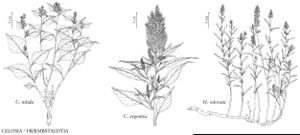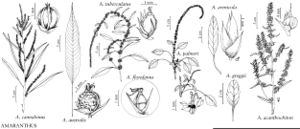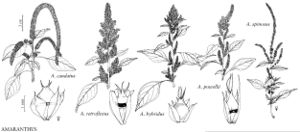Difference between revisions of "Amaranthaceae"
FNA>Volume Importer |
imported>Volume Importer |
||
| (3 intermediate revisions by 2 users not shown) | |||
| Line 162: | Line 162: | ||
|family=Amaranthaceae | |family=Amaranthaceae | ||
|illustrator=Yevonn Wilson-Ramsey | |illustrator=Yevonn Wilson-Ramsey | ||
| + | |illustration copyright=Flora of North America Association | ||
|distribution=Nearly worldwide;most abundant in tropics;subtropics;and warm-temperate regions;evidently absent from alpine and arctic regions. | |distribution=Nearly worldwide;most abundant in tropics;subtropics;and warm-temperate regions;evidently absent from alpine and arctic regions. | ||
|reference=carolin1983a;eliasson1988a;robertson1981a;standley1915a;standley1917b | |reference=carolin1983a;eliasson1988a;robertson1981a;standley1915a;standley1917b | ||
| Line 167: | Line 168: | ||
|publication year= | |publication year= | ||
|special status= | |special status= | ||
| − | |source xml=https:// | + | |source xml=https://bitbucket.org/aafc-mbb/fna-data-curation/src/2e0870ddd59836b60bcf96646a41e87ea5a5943a/coarse_grained_fna_xml/V4/V4_799.xml |
}}<!-- | }}<!-- | ||
-->[[Category:Treatment]] | -->[[Category:Treatment]] | ||
Latest revision as of 22:00, 5 November 2020
Herbs, rarely subshrubs, annual or perennial; trichomes simple (branched in Tidestromia). Stems without nodal spines (Amaranthus spinosus sometimes with paired nodal spines). Leaves alternate or opposite, exstipulate, usually petiolate; blade margins entire (entire or serrulate in Iresine; entire, crispate, or erose in Amaranthus). Inflorescences cymules arranged in spikes, panicles, thyrses, heads, glomerules, clusters, or racemes; each flower subtended by 1 bract and 2 bracteoles (latter sometimes 1 or absent in Amaranthus). Flowers bisexual or unisexual (plants then monoecious or dioecious), hypogynous, generally small or minute; tepals mostly (1–)4–5 or absent, distinct or connate into cups or tubes, scarious, chartaceous, membranaceous, or indurate; stamens 2–5, filaments basally connate into cups or tubes, rarely distinct, alternating with pseudostaminodes (appendages on staminal tubes) or not, anthers 2-locular with 1 line of dehiscence or 4-locular with 2 lines of dehiscence; ovary superior, 1-locular; ovules 1 or, rarely, 2–many; style 1 or absent; stigmas 1–3(–5). Fruits utricles, dry, dehiscent or not. Seeds black, reddish brown, or brown, lenticular, subglobose or globose (rarely cylindric), usually small; embryo peripheral, surrounding mealy perisperm.
Distribution
Nearly worldwide, most abundant in tropics, subtropics, and warm-temperate regions, evidently absent from alpine and arctic regions.
Discussion
Genera ca. 65, species ca. 900 (12 genera, 80 species in the flora).
Centers of diversity for Amaranthaceae are southwestern North America, Central America, South America, and Africa south of the Sahara Desert. Generic limits are not well defined in some groups; fewer than 60 or more than 70 genera could be recognized.
Some species occur in severe habitats such as sandy, calcareous, gypseous, saline, or serpentine soils in deserts, semideserts, and seashores. Some species are weedy, including the major agricultural weeds in Amaranthus. Some species are cultivated as ornamentals, particularly Amaranthus caudatus (love-lies-bleeding), A. hypochondriacus (prince’s-feather), A. tricolor (Joseph’s-coat), Celosia cristata (cockscomb), and Gomphrena globosa (globe-amaranth). Native Americans domesticated white-seeded grain amaranths (A. caudatus, A. cruentus, and A. hypochondriacus) for use as cereal grains. Some species of Amaranthus and Celosia are potherbs.
Amaranthaceae are usually divided into subfamilies Amaranthoideae (anthers 4-locular with two lines of dehiscence) and Gomphrenoideae Schinz (anthers 2-locular with one line of dehiscence). Amaranthaceae and Chenopodiaceae have long been recognized as allied families that share a number of features: generally small flowers, one perianth whorl, a syncarpous gynoecium with a superior ovary and often only one ovule, basal or free-central placentation, pollen characteristics, centrospermous embryo development, betalain pigments, and P-type form (c) sieve-element plastids.
Selected References
Lower Taxa
Illustrations
Key
| 1 | Distal leaves alternate | > 2 |
| 1 | Distal leaves opposite | > 5 |
| 2 | Flowers unisexual (plants monoecious or dioecious); utricles 1-seeded | > 3 |
| 2 | Flowers bisexual; utricles 2+-seeded | > 4 |
| 3 | Shrubs | Iresine |
| 3 | Herbs, annual, rarely perennial | Amaranthus |
| 4 | Leaf blades mostly lanceolate, ovate, or deltate; pseudostaminodes absent | Celosia |
| 4 | Leaf blades linear; pseudostaminodes alternating with filaments on staminal tubes | Hermbstaedtia |
| 5 | Flowers unisexual (plants dioecious); inflorescences terminal, diffuse, open panicles | Iresine |
| 5 | Flowers bisexual; inflorescences terminal and/or axillary glomerules, heads, or spikes | > 6 |
| 6 | Inflorescences sessile glomerules or condensed spikes, axillary | > 7 |
| 6 | Inflorescences pedunculate heads or spikes, terminal and sometimes axillary near stem tips | > 10 |
| 7 | Inflorescences several-flowered, axillary spikes; pseudostaminodes present | Alternanthera |
| 7 | Inflorescences 1-20-flowered, axillary glomerules; pseudostaminodes present or absent | > 8 |
| 8 | Indumentum of branched or barbed trichomes, densely covering plant (rarely glabrous); pseudostaminoides present | Tidestromia |
| 8 | Indumentum of simple trichomes; pseudostaminoides absent | > 9 |
| 9 | Tepals connate proximally, tips 1-veined; filament tubes inserted distally on perianth tubes; basal rosette leaves usually absent at anthesis | Guilleminea |
| 9 | Tepals distinct, 3-veined; filament tubes ± free from tepals; basal rosette leaves present at anthesis | Gossypianthus |
| 10 | Inflorescences simple or compound spikes | > 11 |
| 10 | Inflorescences globose or cylindric heads or spikes | > 12 |
| 11 | Inflorescences mostly compound, interrupted spikes; tepals connate into indurate tubes with lateral crests or spines, lanate | Froelichia |
| 11 | Inflorescences simple spikes or few-branched panicles, flowers progressively farther apart below; tepals basally connate into indurate tubes, without ornamentation, ± glabrous | Achyranthes |
| 12 | Inflorescences not immediately subtended by leaves | Alternanthera |
| 12 | Inflorescences immediately subtended by 2 or more leaves | > 13 |
| 13 | Leaves fleshy, sessile; blade linear to narrowly obovate, glabrous except in axils | Blutaparon |
| 13 | Leaves not fleshy, petiolate or sessile; blade ovate to obovate, pilose at least abaxially | Gomphrena |


